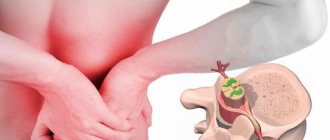Bronchiectasis is a pathological expansion of the walls of the bronchi caused by the destruction of the elastic framework as a result of purulent inflammation. Bronchiectasis can occur in the lungs as a result of frequent and long-term inflammatory diseases (COPD, pulmonary tuberculosis, frequent pneumonia). This phenomenon is called secondary bronchiectasis.
Bronchiectasis is considered a hereditary disease, and its root cause is a genetic defect in elastic fibers, leading to expansion and deformation of “weak” bronchial walls. Bronchiectasis in bronchiectasis is called primary.
Causes of bronchiectasis
Doctors, unfortunately, have not clearly established what causes bronchiectasis.
Presumably the cause of the disease (the appearance of bronchiectasis) are pathogens responsible for the development of acute respiratory processes. Pathogen microorganisms, for example, measles, pneumonia, whooping cough. Especially if we are talking about children, their weak immunity and predisposition to various complications of ARVI. But pathogens can be considered as a provoking factor only conditionally, since most patients fully recovered from the above diseases. Infectious pathogens, for example, pneumococci, staphylococcus, Haemophilus influenzae, can be considered as the cause of exacerbations when the patient has already been diagnosed with chronic bronchitis with bronchiectasis. Since the organ tissues were changed before the infectious agent entered the body, this is more a consequence than a cause of bronchiectasis.
The main cause of acquired bronchiectasis lies in the genetic condition of underdeveloped organs of the respiratory system. This may be congenital deformation of the bronchial walls, smooth muscle dystrophy, underdevelopment of cartilage tissue, low elasticity or rigidity of muscles, weakened immunity, which contributes to the rapid development of concomitant infectious diseases.
Bronchiectasis, the etiology and pathogenesis of which is still under study, is currently classified as a special group of diseases with characteristic dysontogenetic bronchiectasis. Caused by postnatal or acquired expansion of parts of the bronchial tree, as well as functional inferiority of the tissues of the respiratory system.
With etiology, everything is quite arbitrary, but what do we know about the pathogenesis of the disease? To understand the pathogenesis, an important role is played by understanding bronchiectasis as a violation of the patency of the segmental and lobar bronchi, provoking a change in their drainage function, poor outflow of secretory fluid and the formation of atelectasis (obstructive).
Table of contents
— Definition of BEB — Clinical picture of BEB — Classification of BEB — Diagnosis of BEB — Treatment of BEB
In the diagnosis of bronchiectasis during the initial examination, the patient’s complaints and a correctly collected medical history are of great importance. Identification of characteristic anamnestic signs allows the doctor to suspect the presence of bronchiectasis in the patient and prescribe special research methods. Particular attention should be paid to the nature and amount of sputum secreted, the presence of special “drainage” body positions in which its discharge is facilitated. Of particular importance is the mention of frequent respiratory diseases in early childhood, prolonged bronchitis and pneumonia, which were accompanied by prolonged low-grade body temperature and slow recovery. An X-ray of the chest organs in two projections allows us to identify indirect radiological symptoms (criteria), which direct the doctor to further examine the patient and prescribe bronchography or computed tomography. Such radiological symptoms are: 1. Deformation and strengthening of the pulmonary pattern due to peribronchial fibrous and inflammatory changes; looped pulmonary pattern in the region of the basal segments of the lungs.
- Thin-walled ring-shaped shadows (cavities), sometimes with a liquid level. This symptom most often occurs with saccular (cyst-like) bronchiectasis.
- Reduction in the volume of affected lung segments.
- Increased transparency (emphysema) of healthy lung segments.
- Symptom of “amputation” of the lung root.
- Indirect signs of bronchiectasis when localized in the lower lobe of the left lung are a change in the position of the root head of the left lung as a result of a volumetric decrease in the lower lobe, liquefaction of the pulmonary pattern of the upper lobe as a manifestation of compensatory emphysema, displacement of the mediastinal organs to the left as a result of hypoventilation of the lower lobe of the left lung.
- Concomitant fibrosis of the pleura in the lesion. Sometimes - exudative pleurisy.
The next stage of examination of a patient with suspected bronchiectasis is fiberoptic bronchoscopy. This research method allows us to exclude all other causes of obstructive atelectasis - a foreign body of the bronchi, an adenoma (benign tumor) of the bronchi, etc. Bronchiectasis is characterized by signs of limited purulent endobronchitis in the affected segments of the lung. A distinctive feature of such endobronchitis is a significant amount of purulent bronchial secretion, new portions of which come from the distal parts of the bronchial tree when stimulating cough, as well as the low effectiveness of sanitation procedures during repeated examinations. For many decades, bronchography, which is a contrast radiological method for studying the bronchial tree of one or both lungs, has remained the main method for diagnosing bronchiectasis. The most commonly used methods are local anesthesia and the transnasal route of administration of a contrast agent using a rubber catheter. The advantage is given to the administration of viscous aqueous suspensions of iodine-containing organic compounds (for example, ditrast), which are then independently removed from the bronchi by dissolution and coughing. To monitor correct insertion of the catheter, bronchoscopic or fluoroscopic examination can be used. Bronchograms often reveal cylindrical, saccular or spindle-shaped dilatations of the bronchi of the 4th-6th order - bronchiectasis (Fig. 3). Sometimes only indirect signs of bronchiectasis are determined - convergence, deformation and incomplete contrast of the bronchi (symptom of chopped branches). Bronchography allows you to establish the localization, prevalence, form of bronchiectasis, assess the condition of the bronchial tree and its functional features. These characteristics are important for determining the indications and contraindications for surgical treatment of the disease.
Rice. 3 . Bronchogram of the right lung in frontal (a) and lateral (b) projections. Typical branching of the bronchi. The bronchi of the basal segments of the lower lobe are significantly expanded in the form of cylinders and sacs. Small branches of the bronchi are not contrasted. Mixed bronchiectasis of the basal segments of the right lung
Computed tomography of the chest organs provides valuable diagnostic information, which makes it possible to identify bronchiectasis and their localization. Compared to bronchography, it is a safer research method. After it is carried out, there is no exacerbation of the inflammatory process in bronchiectasis, as is often the case with bronchography. However, computed tomography is inferior in diagnostic capabilities to bronchography, especially when deciding on surgical intervention. MM. Savula et al. (2000) identify the following diagnostic criteria for bronchiectasis:
- typical medical history (onset of illness in childhood or young age after pneumonia, infectious diseases), cough with purulent sputum, periodic hemoptysis;
- persistent moist wheezing in the same place, the number of which decreases after sputum production;
- X-ray - multiple ring-shaped shadows, mainly in the lower parts of the lungs (usually on the left);
- saccular or cylindrical dilations of the bronchi, which are detected by bronchography.
Taking into account our many years of experience, we believe that these criteria need to be supplemented with the following:
- repeated pneumonia of one localization, typical of bronchiectasis, over several years in children and young people;
Table 2. DIAGNOSTIC CRITERIA FOR BRONCHIECTATIC DISEASE
| Research method | Diagnostic criteria |
| Questioning the patient (complaints and anamnesis) |
|
| Auscultation of the lungs | 6. Persistent moist wheezing in the same place, the number of which decreases after sputum discharge |
| X-ray of the chest organs in two projections |
|
| Fiberoptic bronchoscopy | Limited purulent endobronchitis of localization typical for bronchiectasis with a torpid course, despite repeated sanitation and antibiotic therapy |
| Bronchography |
|
- the phenomenon of limited purulent endobronchitis of localization typical for bronchiectasis with a large amount of purulent bronchial secretion and a protracted course, despite repeated endoscopic sanitation and antibiotic therapy;
- looped pulmonary pattern in the area of segments that are most often affected by bronchiectasis, combined with signs of hypoventilation in these segments of predominantly young people;
- convergence, deformation and incomplete contrasting of the bronchi (symptom of chopped branches), which are detected by bronchography.
Summarizing the above, the diagnostic criteria for bronchiectasis can be displayed in a certain sequence (Table 2). A conclusion about the primary or secondary nature of bronchiectasis can be made on the basis of a comprehensive analysis of clinical, laboratory and instrumental examination of the lungs. If lung diseases that lead to the formation of secondary bronchiectasis (tuberculosis, cystic fibrosis, staphylococcal lung destruction, etc.) are excluded, a diagnosis of bronchiectasis is made.
Types of bronchiectasis
Irreversible dilations are bronchiectasis, the classification of which takes into account the form of change in bronchial tissue:
- pouch type;
- cylindrical;
- fusiform;
- mixed.
There are a large number of transitional forms, the definition of which is often determined by the doctor in any order. Bronchiectasis in the lungs is usually classified according to etiological criteria:
- the result of hereditary diseases: Kartagener, Down, Shwachman-Diamond, Williams-Campbell syndromes, cystic fibrosis) and others with a similar etiology;
- the result of intrauterine infection, for example, with the Epstein-Barr virus;
- secondary bronchiecstasis, which developed as a consequence of other bronchopulmonary pathologies. Abscesses, tuberculosis, bacterial pneumonia, etc.
Speaking about bronchiectasis of the lungs, it is worth mentioning the division of bronchial dilations into atelectatic and not associated with the risk of suffocation.
Prevention measures
To prevent the development of this pathology, it is necessary to treat all respiratory diseases in a timely manner. Self-medication is unacceptable, especially in children. It has been noted that timely vaccination against measles, whooping cough and other diseases that can lead to the development of bronchiectasis significantly reduces the number of patients. Vaccinations for adults against influenza and pneumococcal infections also help in prevention. And proper treatment of bronchial asthma will help prevent pathological changes in the bronchi.
Prevention of bronchiectasis involves preventing colds. To do this, you need to harden yourself, avoid hypothermia, and get rid of bad habits. To prevent this pathology, you may have to change your job or place of residence if they are associated with inhaling large amounts of harmful gases.
Symptoms
Bronchiectasis is symptomatically similar to obstructive changes that have a different, non-genetic or non-infectious origin. Signs of irreversible expansions:
- asthenia, manifested in the form of weakness, a sharp decrease in body weight and fatigue;
- change in the shape of the sternum, its barrel-shaped protrusion;
- hard breathing and wheezing on auscultation;
- with bronchiectasis, sputum with a predominance of purulent inclusions, hemoptysis;
- chest pain, fever;
- pale skin, severe cyanosis;
- expiratory dyspnea.
To establish a diagnosis, instrumental and evidence-based diagnostics are required.
Necessary diagnostics
Before treatment, a diagnosis must be carried out. It is necessary to exclude other diseases (primary pneumonia, silicosis, tuberculosis, asthma). The following studies will be needed:
- chest percussion;
- listening to the lungs and heart;
- X-ray examination;
- examination of the bronchi;
- bronchography;
- carrying out functional tests;
- assessment of blood gas composition;
- spirometry;
- blood and urine tests;
- sputum examination;
- electrocardiography;
- Ultrasound of the heart;
- CT scan.
The most reliable diagnostic methods are computed tomography, bronchoscopy and bronchography. During bronchography, a dye is injected and an x-ray is taken. This examination requires local or general anesthesia. Bronchography reveals the following changes:
- deformation of the bronchi;
- their rapprochement;
- signs of obstruction.
Diagnostic and treatment procedures include bronchoscopy. The doctor uses a special device to examine the bronchi. During bronchoscopy, a secretion is taken for examination. Radiography is also of great value. It is carried out in 2 projections and reveals the cellularity of the lungs, decreased airiness in certain areas and uneven distribution of air. In the process of laboratory blood tests, it is possible to detect leukocytosis, shift to the left, anemia, increased levels of sialic acid, seromucoid, fibrin and haptoglobin.
The patient's medical history is of great importance for making a diagnosis. The doctor must identify possible risk factors (indications of a history of frequent pneumonia or acute respiratory illnesses, smoking, contact with dust at work). During a physical examination, dullness of sound in certain areas, the presence of airless zones, harsh breathing, and moist rales are detected.
Treatment
Bronchiectasis requires constant but supportive treatment. Therapy is aimed at improving the patient’s quality of life, since complete recovery is impossible due to the irreversibility of destruction. Antibacterial agents, immunomodulators, mucolytic drugs, and proteolytic enzymes are prescribed. In case of complications, drainage of the bronchi and trachea and surgical intervention for atelectasis are used.
Diet for bronchiectasis - table No. 13.
Bronchiectasis in children
The actions of pediatricians should be aimed not only at the early detection and diagnosis of genetically determined diseases, but also at the prevention (rational treatment) of pneumonia in infancy and preschool age. Bronchiectasis, the treatment of which has been neglected, in the natural course of the disease leads to very serious consequences, including death from suffocation.











